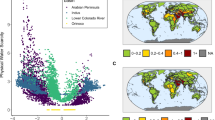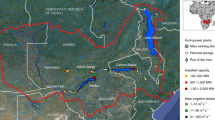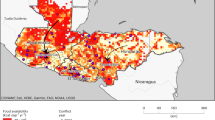Abstract
Increasing Earth’s surface air temperature yields an intensification of its hydrological cycle1. As a consequence, the risk of river floods will increase regionally within the next two decades due to the atmospheric warming caused by past anthropogenic greenhouse gas emissions2,3,4. The direct economic losses5,6 caused by these floods can yield regionally heterogeneous losses and gains by propagation within the global trade and supply network7. Here we show that, in the absence of large-scale structural adaptation, the total economic losses due to fluvial floods will increase in the next 20 years globally by 17% despite partial compensation through market adjustment within the global trade network. China will suffer the strongest direct losses, with an increase of 82%. The United States is mostly affected indirectly through its trade relations. By contrast to the United States, recent intensification of the trade relations with China leaves the European Union better prepared for the import of production losses in the future.
This is a preview of subscription content, access via your institution
Access options
Access Nature and 54 other Nature Portfolio journals
Get Nature+, our best-value online-access subscription
$29.99 / 30 days
cancel any time
Subscribe to this journal
Receive 12 print issues and online access
$209.00 per year
only $17.42 per issue
Buy this article
- Purchase on Springer Link
- Instant access to full article PDF
Prices may be subject to local taxes which are calculated during checkout




Similar content being viewed by others
References
IPCC Climate Change 2013: The Physical Science Basis (eds Stocker, T. F. et al.) (Cambridge Univ. Press, 2013).
Willner, S. N., Levermann, A., Zhao, F. & Frieler, K. Adaptation required to preserve future high/end river flood risk at present levels. Sci. Adv. 4, eaao1914 (2018).
Hirabayashi, Y. et al. Global flood risk underclimate change. Nat. Clim. Change 3, 816–821 (2013).
Jongman, B., Ward, P. J. & Aerts, J. C. J. H. Global exposure to river and coastal flooding: Long term trends and changes. Glob. Environ. Change 22, 823–835 (2012).
Jongman, B. et al. Increasing stress on disaster-risk finance due to large floods. Nat. Clim. Change 4, 264–268 (2014).
Winsemius, H. C. et al. Global drivers of future river flood risk. Nat. Clim. Change 6, 381–385 (2015).
Acemoglu, D., Carvalho, V. M., Ozdaglar, A. & Tahbaz-Salehi, A. The network origins of aggregate fluctuations. Econometrica 80, 1977–2016 (2012).
Burke, M., Hsiang, S. M. & Miguel, E. Global non-linear effect of temperature on economic production. Nature 527, 235–239 (2015).
Carleton, T. A. & Hsiang, S. M. Social and economic impacts of climate. Science 353, aad9837 (2016).
Hsiang, S. M., Burke, M. & Miguel, E. Quantifying the influence of climate on human conflict. Science 341, 1235367 (2013).
Hsiang, S. et al. Estimating economic damage from climate change in the United States. Science 356, 1362–1369 (2017).
IPCC Climate Change 2014: Impacts, Adaptation, and Vulnerability (eds Field, C. B. et al.) (Cambridge Univ. Press, 2014).
Hallegatte, S., Green, C., Nicholls, R. J. & Corfee-Morlot, J. Future flood losses in major coastal cities. Nat. Clim. Change 3, 802–806 (2013).
Hallegatte, S. Modeling the roles of heterogeneity, substitution, and inventories in the assessment of natural disaster economic costs. Risk Anal. 34, 152–167 (2014).
Maluck, J. & Donner, R. V. A network of networks perspective on global trade. PLoS ONE 10, e0133310 (2015).
Levermann, A. Make supply chains climate-smart. Nature 506, 27–29 (2014).
Henriet, F., Hallegatte, S. & Tabourier, L. Firm-network characteristics and economic robustness to natural disasters. J. Econ. Dynam. Control 36, 150–167 (2012).
Hallegatte, S. An adaptive regional input–output model and its application to the assessment of the economic cost of Katrina. Risk Anal. 28, 779–799 (2008).
Wenz, L. & Levermann, A. Enhanced economic connectivity to foster heat stress-related losses. Sci. Adv. 2, e1501026 (2016).
Hallegatte, S. Economic Resilience: Definition and Measurement (World Bank Group, 2014); https://doi.org/10.1596/1813-9450-6852
Kwak, Y., Takeuchi, K., Fukami, K. & Magome, J. A new approach to flood risk assessment in Asia-Pacific region based on MRI-AGCM outputs. Hydrol. Res. Lett. 6, 70–75 (2012).
Otto, C., Willner, S. N., Wenz, L., Frieler, K. & Levermann, A. Modeling loss-propagation in the global supply network: The dynamic agent-based model Acclimate. J. Econ. Dynam. Control 83, 232–269 (2017).
Jiang, L. & O’Neill, B. C. Global urbanization projections for the shared socioeconomic pathways. Glob. Environ. Change 42, 193–199 (2017).
Taylor, K. E., Stouffer, R. J. & Meehl, G. A. An overview of CMIP5 and the experiment design. Bull. Am. Meteorol. Soc. 93, 485–498 (2012).
Warszawski, L. et al. The Inter-Sectoral Impact Model Intercomparison Project (ISI-MIP): project framework. Proc. Natl Acad. Sci. USA 111, 3228–3232 (2014).
Weedon, G. P. et al. Creation of the watch forcing data and its use to assess global and regional reference crop evaporation over land during the twentieth century. J. Hydrometeorol. 12, 823–848 (2011).
Hempel, S., Frieler, K., Warszawski, L., Schewe, J. & Piontek, F. A trend-preserving bias correction-the ISI-MIP approach. Earth Syst. Dynam. 4, 219–236 (2013).
Bondeau, A. et al. Modelling the role of agriculture for the 20th century global terrestrial carbon balance. Glob. Change Biol. 13, 679–706 (2007).
Rost, S. et al. Agricultural green and blue water consumption and its influence on the global water system. Water Resour. Res. 44, W09405 (2008).
Yamazaki, D., Kanae, S., Kim, H. & Oki, T. A physically based description of floodplain inundation dynamics in a global river routing model. Water Resour. Res. 47, W04501 (2011).
Zhao, F. et al. The critical role of the routing scheme in simulating peak river discharge in global hydrological models. Environ. Res. Lett. 12, 075003 (2017).
Scussolini, P. et al. Flopros: an evolving global database of flood protection standards. Nat. Hazards Earth Syst. Sci. 16, 1049–1061 (2016).
Takata, K., Emori, S. & Watanabe, T. Development of the minimal advanced treatments of surface interaction and runoff. Glob. Planet. Change 38, 209–222 (2003).
Kim, H., Yeh, P. J. F., Oki, T. & Kanae, S. Role of rivers in the seasonal variations of terrestrial water storage over global basins. Geophys. Res. Lett. 36, L17402 (2009).
Bierkandt, R., Wenz, L., Willner, S. N. & Levermann, A. Acclimate - a model for economic damage propagation. Part I: basic formulation of damage transfer within a global supply network and damage conserving dynamics. Environ. Syst. Decis. 34, 507–524 (2014).
Wenz, L., Willner, S. N., Bierkandt, R. & Levermann, A. Acclimate - a model for economic damage propagation. Part II: a dynamic formulation of the backward effects of disaster-induced production failures in the global supply network. Environ. Syst. Decis. 34, 525–539 (2014).
Lenzen, M., Kanemoto, K., Moran, D. & Geschke, A. Mapping the structure of the world economy. Environ. Sci. Technol. 46, 8374–8381 (2012).
CIESIN Gridded Population of the World, Version 4 (GPWv4): Population Count (NASA SEDAC, 2016); https://doi.org/10.7927/H4X63JVC
GADM Database of Global Administrative Areas version 2.8 (GADM, 2015); https://www.gadm.org
Wenz, L. et al. Regional and sectoral disaggregation of multi-regional input-output tables-a flexible algorithm. Econ. Syst. Res. 27, 194–212 (2015).
Alfieri, L. et al. Global projections of river flood risk in a warmer world. Earth’s Future 5, 171–182 (2017).
Huizinga, H., de Moel, H. & Szewczyk, W. Global Flood Depth-Damage Functions— Methodology and the Database with Guidelines (European Commission, 2017); https://doi.org/10.2760/16510
Jongman, B. et al. Comparative flood damage model assessment: Towards a European approach. Nat. Hazards Earth Syst. Sci. 12, 3733–3752 (2012).
Acknowledgements
The authors would like to thank F. Zhao for preparing the flood projections with CaMa-Flood, the working group around Y. Hirabayashi, and especially D. Yamazaki, for providing the MATSIRO return period to flood depth mapping data. This research has received funding from the European Union Seventh Framework Programme FP7/2007–2013 (grant agreement 603864), from the Horizon 2020 Framework Programme of the European Union (grant agreement 641811), from the framework of the Leibniz Competition (SAW-2013-PIK-5) and from the Initiative on Extreme Weather and Climate, as well as from the Center for Climate and Life of Columbia University, New York, New York.
Author information
Authors and Affiliations
Contributions
All authors designed the research. S.W. and C.O. developed the loss-propagation model. S.W. and A.L. conducted the analysis. All authors discussed the analysis and wrote the manuscript.
Corresponding author
Ethics declarations
Competing interests
The authors declare no competing interests.
Additional information
Publisher’s note: Springer Nature remains neutral with regard to jurisdictional claims in published maps and institutional affiliations.
Supplementary information
Supplementary Information
Supplementary Figures 1–5, Supplementary Table 1
Supplementary Video 1
Supplementary Video
Rights and permissions
About this article
Cite this article
Willner, S.N., Otto, C. & Levermann, A. Global economic response to river floods. Nature Clim Change 8, 594–598 (2018). https://doi.org/10.1038/s41558-018-0173-2
Received:
Accepted:
Published:
Issue Date:
DOI: https://doi.org/10.1038/s41558-018-0173-2
This article is cited by
-
Using urban pasts to speak to urban presents in the Anthropocene
Nature Cities (2024)
-
Reversal of the levee effect towards sustainable floodplain management
Nature Sustainability (2023)
-
The impacts of impervious surface expansion and the operation of polders on flooding under rapid urbanization processes
Theoretical and Applied Climatology (2023)
-
Evolution characteristics of the rainstorm disaster chains in the Guangdong–Hong Kong–Macao Greater Bay Area, China
Natural Hazards (2023)
-
The effect of rainfall changes on economic production
Nature (2022)



